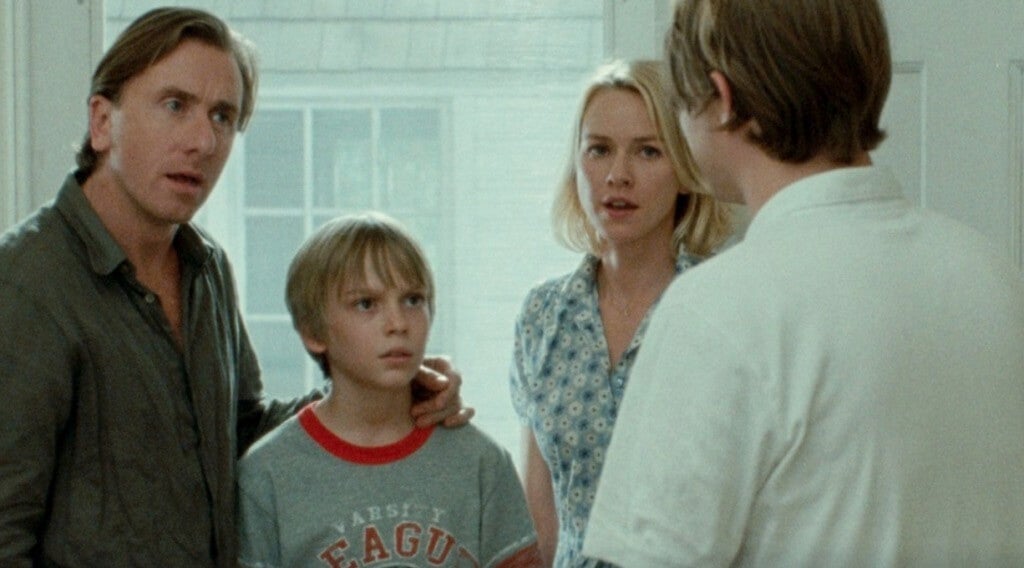Violence Gratuit is an American film by Michael Haneke and a fully faithful replica of the Austrian version released in German with the same title and director in 1997. The film is about the aggression perpetrated by two young men against a family on vacation.
This could be a violent thriller like any other, but it’s not the plot that makes Free Violence special, this is the lesson we want to teach viewers, criticizing the massive violent and tasteless entertainment of many film productions that invade our homes.
- Free Violence criticizes vulgar and violent entertainment.
- A kind of treatment for an audience obsessed with the occasional consumption of images of suffering.
Free Violence (both in the Austrian version and in the American remake) aims to make the viewer understand how he is a regular accomplice to the violence he witnesses, in his environment or as a viewer of films.
The film begins with Ann and George (Naomi Watts and Tim Roth) driving around the country in a summer house with Georgie (Devon Gearhart), their son. During their journey in the family’s Land Rover, they listen to an opera CD. arrive, tow a nice wooden sailboat.
As they move into the holiday home, two young men who speak well but are strangers, show up at the door. Because they both have impeccable manners and are apparently members of the rich white club, they have easy access to the house. And here, the nightmare begins.
The family confronts two young sociopaths at the oratory on the right who, the next night, torment them with a knife, a pistol, a golf club and impeccable manners.
The two are addressed in different ways. Sometimes like Peter and Paul, sometimes like Tom and Jerry or Beavis and Butt-Head. They are played by Michael Pitt and Brady Corbet.
Peter and Paul operate for no identifiable reason or affection. When George, the father, asks one of them why he is so cruel, the character gives answers that stop the kind of easy story the viewer expects.
He alludes to his unhappy childhood, sexual instability, class resentment or lack of education, everything is typical, expected and explains nothing. In these situations, Haneke mocks the simple arguments to explain the psychology of the characters who use the media.
Peter and Paul wear immaculate white gloves as they perform their terrible feats. On some occasions, Mr. Pitt speaks directly to the public, mocking us for supporting Anne and George’s survival.
The film makes small allusions to the complicity that the viewer acquires with the violent plot that unfolds.
There are explicit nods from the actors to the camera as they manipulate the victims in a macabre on-screen game. Recreating a common scene in the kitchen mimicking what many of us do when consuming a violent cinema makes it light.
“Why don’t we kill and get this over with?” expresses George’s beaten character. The torturer’s answer is, “But what would entertainment be?”In the meantime, we’re involved in this horrible spectacle.
Michael Haneke is a director of Austrian nationality who has accustomed us to unconventional stories, with entertainment linked at all times to the reflection of his sequences.
Haneke’s violence is not funny, elegant, sexy, not even particularly dramatic, it is simple and relentlessly unpleasant. There are not even real developments in the plot to disperse or deflect agony.
The purpose of Free Violence is to confront our hypocritical taste for modern Hollywood violence in its various genres. We see violence on screen as something distant, ephemeral, alien to our daily lives.
The film shows that there is no familiar, residential or professional perfection that takes us far enough away from a dangerous situation, we are not prepared to react to what we would be extremely vulnerable to, humans, nothing to do with Hollywood perfection.
Haneke wants to highlight us, the viewers, and tries to realize his desire by anticipating the conclusions of our reflections. See how all our deductions seem to be harder?Years spent watching violent cinema for commercial purposes.
That’s why the film deceives us, mainly with the clues that we think will be relevant to the family of the drama you’re going through. Tracks or evidence usually associated with other violence films, nothing further from reality, as these tracks do not become relevant throughout the film.
Assaults are neither logical nor expected. Gender roles are reversed, the flight from the scene is not heroic, and the end of the characters is also not full of mystery. The leak, something that always provides many events along the plot, is absolutely prevented and attacked from the beginning.
It is a dry violence, without flourishes, without unnecessary staging on screen, it is a violence recreated in our psychology precisely because it challenges it from what the media shows us.
Free Violence is a must if you want to challenge your usual cinematic standards and consumable if you want to consume cinema with a dose of violence in your role as an ordinary viewer.

